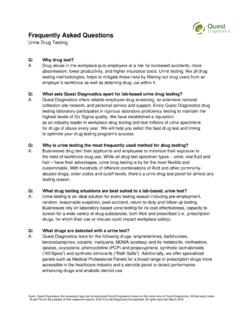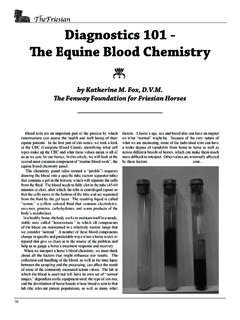Transcription of HIV ASSAYS: OPERATIONAL CHARACTERISTICS - …
1 hiv assays : OPERATIONAL CHARACTERISTICS . (PHASE 1). REPORT 15. ANTIGEN/ANTIBODY ELISAs World Health Organization hiv assays : OPERATIONAL CHARACTERISTICS . (PHASE 1). REPORT 15. ANTIGEN/ANTIBODY ELISAs World Health Organization Department of Essential Health Technologies WHO Library Cataloguing-in-Publication Data World Health Organization. hiv assays : OPERATIONAL CHARACTERISTICS (Phase 1) : report 15 antigen/antibody ELISAs antigens - analysis infections diagnosis seropositivity - diagnosis serodiagnosis - methods kits, Diagnostic - utilization trials, Phase I ISBN 92 4 159237 0 (NLM classification: WC ). World Health Organization, 2004. All rights reserved. Publications of the World Health Organization can be obtained from Marketing and Dissemination, World Health Organization, 20 Avenue Appia, 1211 Geneva 27, Switzerland (tel: +41 22 791 2476; fax: +41 22 791 4857; email: Requests for permission to reproduce or translate WHO publications whether for sale or for noncommercial distribution should be addressed to Publications, at the above address (fax: +41 22 791 4806.))
2 Email: The designations employed and the presentation of the material in this publication do not imply the expression of any opinion whatsoever on the part of the World Health Organization concerning the legal status of any country, territory, city or area or of its authorities, or concerning the delimitation of its frontiers or boundaries. The mention of specific companies or of certain manufacturers' products does not imply that they are endorsed or recommended by the World Health Organization or UNAIDS in preference to others of a similar nature that are not mentioned. Errors and omissions excepted, the names of proprietary products are distinguished by initial capital letters. WHO, UNAIDS, and the Institute of Tropical Medicine, Antwerp, Belgium, do not warrant or represent that the evaluations conducted with the HIV test kits referred to in this document are accurate, complete and/or error-free.
3 WHO, UNAIDS and the Institute of Tropical Medicine disclaim all responsibility for any use made of the data contained herein, and shall not be liable for any damages incurred as a result of its use. This document must not be used in conjunction with commercial or promotional purposes. Printed in France _____. Contact: Dr G. Vercauteren, Essential Health Technologies - WHO - 20, Avenue Appia - 1211. Geneva 27- Switzerland This document is available on the internet at: hiv assays : OPERATIONAL CHARACTERISTICS (Phase I). REPORT 15. ANTIGEN/ANTIBODY ELISAs CONTENTS. Page 1. Summary 1. 2. Background information 1. 3. Laboratory diagnosis of HIV infection 2. A brief overview 2. HIV testing strategies 3. Follow-up after diagnosis 7.
4 Quality assurance 8. Safety 8. 4. assay selection 8. 5. Materials and methods of assessment 9. assay kits 9. Equipment used 11. Evaluation panels 11. WHO HIV panel 11. Seroconversion panels 12. Performance panels 12. Test performance 12. Reference tests 12. Analysis of the results of the assays under evaluation 13. Sensitivity, specificity and predictive values of HIV serological tests 13. Sensitivity in seroconversion panels 15. Sensitivity in performance panels 15. Additional analyses 15. 6. assay evaluations 15. assay evaluations 16. Table 1: General CHARACTERISTICS and OPERATIONAL aspects 17. Table 2: Comparison of the assays with reference tests 18. Table 3: Detailed OPERATIONAL aspects 19. Table 4a: Technician's appraisal of the test kit 21.
5 Table 4b: Calculation of ease of performance 22. Table 5: Technical suitability for use in small laboratories 23. Table 6: Results on commercial seroconversion panels 24. Table 7: Results on commercial anti-HIV 1 performance panel 26. Table 8: Results on commercial HIV p24 antigen performance panel 27. Figure 4: Relative performance on seroconversion panels 28. Figure 5: Relative performance on seroconversion and mixed titre panels 29. Explanatory notes for Tables 1 - 8 30. 7. Annexes Annex 1: Cumulative list of assays evaluated whose production has been discontinued 33. Annex 2: Cumulative list of assays evaluated; currently commercially available 41. Annex 3: Cumulative list of assay manufacturers' addresses 50. Annex 4: WHO HIV Bulk Procurement 55.
6 8. Acknowledgments 57. Page 1. 1. Summary Report 15 summarises the assessment of the major OPERATIONAL CHARACTERISTICS of commercially available assays to detect HIV antigen and antibodies to HIV1 and HIV 2. The data that is presented was obtained in the Phase I evaluation of the following 5. ELISA assays carried out between August 2003 and July 2004. Assays evaluated Enzygnost HIV Integral II (Dade Behring Marburg GmbH). Genedia HIV Ag-Ab ELISA (Green Cross Life Science Corporation). Genscreen Plus HIV Ag-Ab (Bio-Rad Laboratories). Murex HIV Ag/Ab Combination (Abbott/Murex). Vironostika HIV Uni-Form II Ag/Ab (bioM rieux bv). Section 2 of this report provides background information on the series. Sections 3 and 4 provide an overview of the laboratory diagnosis of HIV and comments on assay selection.
7 Section 5 outlines how the assessments were carried out. Details of the results of the assay evaluations are contained in the tables in section 6. Cumulative lists of the assays already assessed under the programme and the addresses of manufacturers are given in Annexes 1-3. 2. Background information In 1988, the World Health Organization (WHO) Global Programme on AIDS (GPA), conscious of the need to advise Member States on the laboratory diagnosis of HIV, initiated a programme to provide objective assessments of commercially available assays for detecting antibody to both types of HIV, HIV-1 and HIV-2. The programme has been extended to include assays which also detect HIV antigen (HIV Ag/Ab assays). The laboratory aspects of this continuing programme is carried out by the WHO.
8 Collaborating Centre for HIV/AIDS Diagnostic and Laboratory Support in the Department of Microbiology, Institute of Tropical Medicine, Antwerp, Belgium and coordinated by the Department of Essential Health Technologies of WHO in conjunction with UNAIDS. The assessments focus on the OPERATIONAL CHARACTERISTICS of these assays, such as ease of performance and their sensitivity and specificity on a panel of well-characterized sera of diverse geographical origins, and indicate their suitability for use in small laboratories, many blood-collection centres in developing countries. Additionally, the sensitivity of the assays on eight commercial seroconversion panels, one anti- HIV 1 mixed titer performance panel and one HIV 1 p24 antigen mixed titer performance panel are assessed.
9 The assessments are published in the form of reports which are intended for use by health policy-makers, directors of blood banks, and managers of national AIDS. prevention programmes. They may be used in conjunction with consideration of other factors, such as experience with a given test, availability, cost, service and trouble- shooting provided locally by manufacturers, etc., to help select HIV antibody and/or HIV Ag/Ab assays appropriate to local needs. Page 2. The first report was issued in March 1989, and subsequent reports have been issued on a regular basis; details are given in Annexes 1 and 2. Recent reports are also published on the WHO website and can be found as follows: Further copies of this and earlier reports are available on request from the Department of Essential Health Technologies, World Health Organization, 1211 Geneva 27, Switzerland.
10 Reports containing information of assays which are currently no longer available are taken out of distribution. 3. Laboratory diagnosis of HIV infection A brief overview The diagnosis of HIV infection is usually made on the basis of the detection of HIV. antibodies and/or antigen. Serological tests for detecting antibodies to HIV are generally classified as screening tests (sometimes referred to as initial tests) or confirmatory tests (sometimes referred to as supplemental tests). Those tests which simultaneously detect HIV antibody and antigen are usually referred to as enhanced screening tests. Initial tests provide the presumptive identification of antibody-positive, or antibody/antigen positive, specimens, and supplemental tests are used to confirm whether specimens found reactive with a particular screening test contain antibodies specific to HIV and/or the presence of HIV antigen.

















